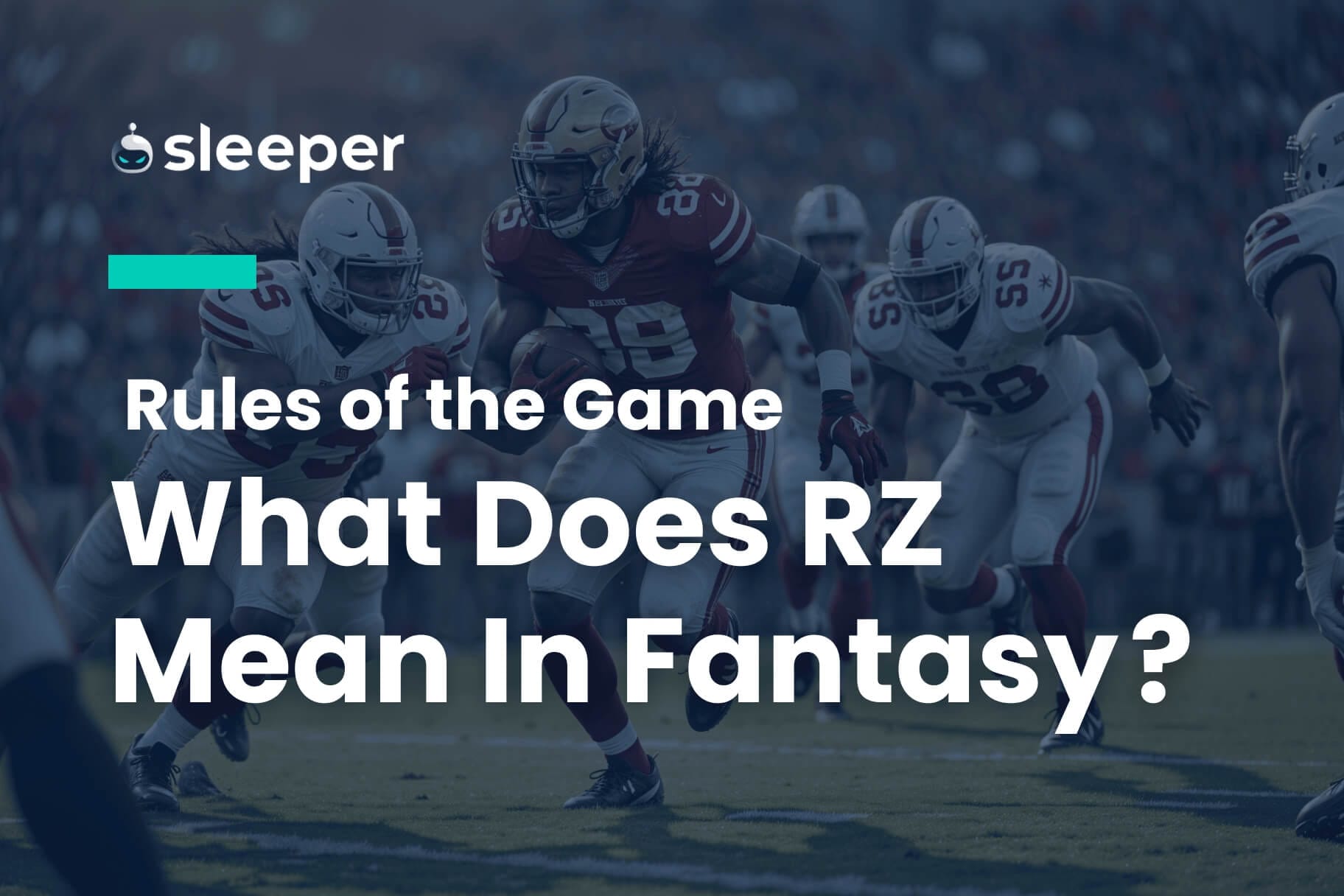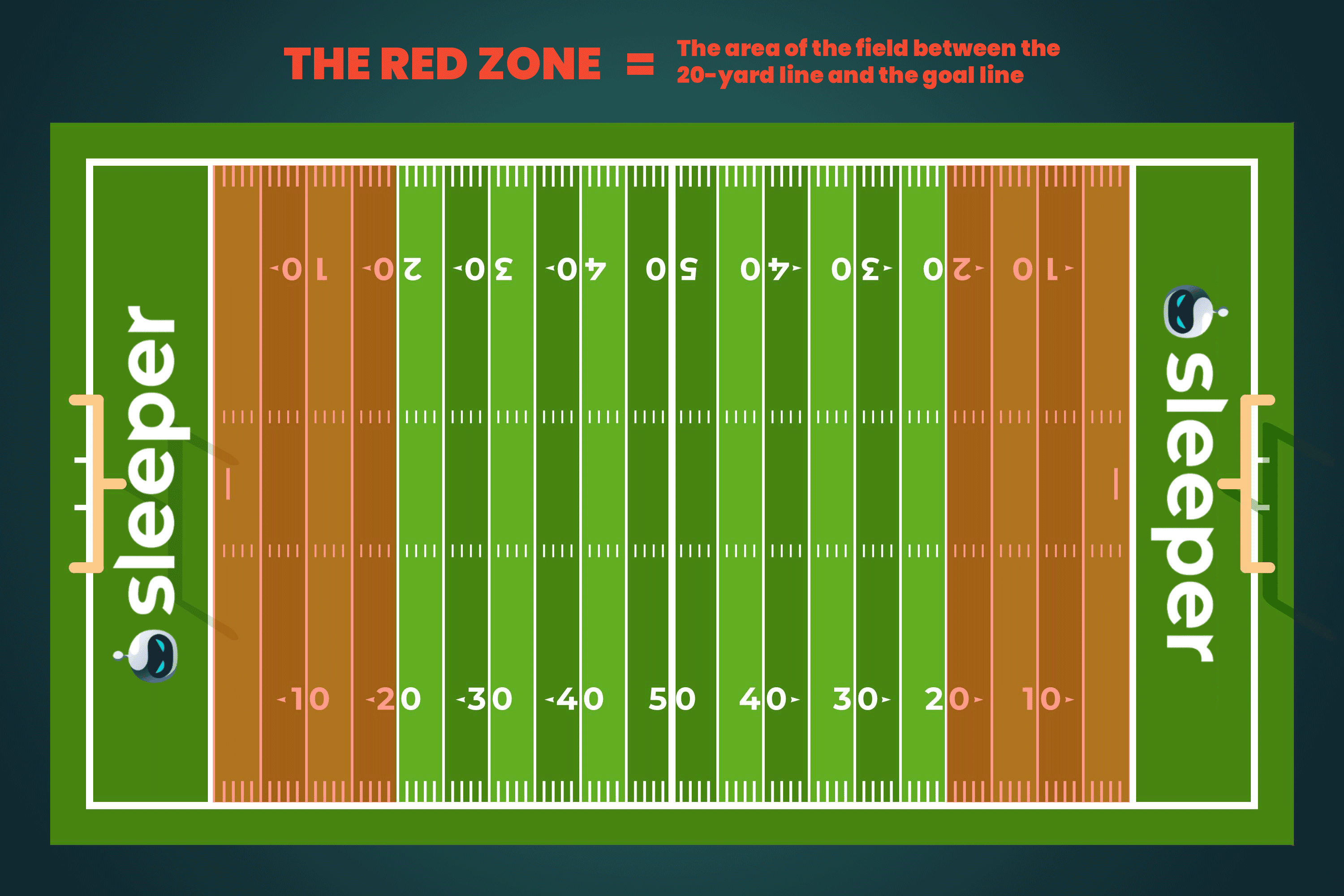What Does RZ Mean in Fantasy Football?

Fantasy football apps and platforms are full of shorthand, as any experienced player knows. Throughout the week and on gameday, as players’ statuses change, certain letters and acronyms will pop up next to their names. Each has a different meaning, and managers should familiarize themselves with these terms so they can be fully prepared to act as needed to maximize results.
One incredibly encouraging set of letters in particular is worth getting to know: RZ. Read on to learn more about “RZ” — and the rest of the fantasy football alphabet soup.
What RZ Means in Fantasy Football
Whenever you see “RZ” in a fantasy football app, it’s referring to “red zone” (sometimes all one word, redzone), which is the area between an opponent’s 20-yard line and the end zone.
When RZ pops up next to a player's name on your roster, the possibilities start to percolate; you just might be on a trip to touchdown city.
Conversely, if your opponent has RZ next to its players names on a regular basis, it could be a long and painful week of scoreboard watching.
Regardless, it’s the indicator that marks the lifeblood of every fantasy week: points, or at the very least the potential for them, are on the way.

The Importance of RZ In Fantasy Football
When teams are in the red zone, that means they’re on the doorstep of scoring, and with touchdowns being the best way to score fantasy points in bulk, you’ll want to know when your players are right there.
Sure, big plays happen with relative frequency, but teams are far more likely to punch in a TD (or kick a field goal) from in close.
If your roster is big on goal-line running backs, for instance, you’ll start to build with excitement and anticipation as those players’ teams get closer and closer to hitting paydirt.
“Red zone” is such a prominent football term that the NFL has its own “RedZone” channel on TV, which is every fantasy player’s best friend. The network jumps from game to game whenever teams are in the red zone (or just had a big play that gets them close) and makes sure to show every scoring play throughout a football Sunday.
More Fantasy Football Shorthand You Should Know
RZ is just one abbreviation or piece of fantasy football shorthand that should be part of your lexicon. Beyond that, there’s plenty more:
NA/IA (Inactive)
About 90 minutes before kickoff, teams will release status reports for their respective games. If a player is listed as inactive, you’ll want to get them out of your lineups ASAP and plug in a replacement. It’s important to always check the active/inactive reports on gameday, even if you aren’t expecting any absences. It’s always better to be safe and assume nothing.
NA could also refer to someone who is an active player but not currently on an active roster. It could be someone who is on a practice squad but hasn’t been called up to the full team, or perhaps someone who is a free agent and doesn’t have a team at all.
SUSP/SSPD (Suspended)
Players who are being disciplined by the league or their team will be clearly marked accordingly. Under no circumstances should you start a player with SUSP or SSPD next to his name.
PUP (Physically Unable to Perform)
Players on the PUP list are due to miss a minimum amount of time and could be out for the long haul, with teams just harboring hope of a comeback. Only well-stocked fantasy teams with roster space to spare (or those in dynasty leagues looking at a multi-year process) should take on PUP players.
IR (Injured Reserve)
That’s the distinction given to a player on IR. If it’s the temporary IR and not the season-long IR, that player will come back after a certain amount of time, and if it’s a player of a certain quality, he’ll be worth stashing until that return happens.
Some leagues will also offer additional IR roster spots, which allows you to take on an extra bench player — at least until your player on IR returns. Then you’ll have a cut to make to keep within roster guidelines.
O (Out)
If a player gets hurt in the course of a game and he’s ruled out for the rest of the contest, an “O” will typically pop up next to his name. It’s one of the most helpless feelings a fantasy manager can have, because it’s too late to replace him. And if it happens early in a game, chances are you’re taking a 0 on the scoreboard for the player who has the O.
D (Doubtful)
The second-most severe letter on gameday is the D. When a player is doubtful to return, it’s highly unlikely he sees the field again. It’ll give you false hope, but it almost definitely means his day is done. Teams give that distinction when there’s a 25% chance of return, but typically it’s going to be less than that.
Another use comes during the course of the practice week, when injury statuses are detailed daily. If a player is doubtful at any point before his team plays, you should be planning on finding a reliable backup option.
Q (Questionable)
A player who is questionable is either 50-50 to come back on gameday or 50-50 to suit up to begin with. It could certainly and literally be worse, but if he has that distinction during the week, you’ll want to pay close attention to the injury report on gameday and start considering alternatives.
P (Probable)
If there has to be an injury distinction given, this is the best letter you can see, after a player of yours gets dinged up either in practice or during a game. It likely means he’s either going to be playing that day or is headed back in after a play or few off if the injury happens during the course of a game. You should be able to get back to racking up the fantasy points with anyone who is probable.
See also: How to Play Fantasy Football: A Complete Guide
Red Zone Frequently Asked Questions
What does RZ mean in Sleeper?
RZ in Sleeper means the same thing it means on other fantasy platforms. It indicates that players are in the red zone and a scoring opportunity could be in the offing. It also means it’s a good time to hit Sleeper’s live scoreboard to follow the play-by-play and track how the drive ends in real time.
Is red good or bad in fantasy football?
Red may mean “stop” on a traffic light, but it’s all systems go when it comes to fantasy football as long as it refers to the red zone. You want your players in the red zone as often as possible.
If it refers to the color of a player’s matchup, then that’s a different story. When operating your season-long fantasy football league on Sleeper, you’ll notice that players’ opponents on a given week are either in green, yellow or red font. If it’s in red font, that means your player has a tough matchup. It doesn’t necessarily mean you sit that player, but you might want to temper expectations for that week.
What is the green zone in fantasy football?
The green zone can mean a couple of things. For most references, it deals with plays from the 5-yard line and in, although it’s not a very widely used term. If you think a player in the red zone brings on mouthwatering possibilities, plays that bring on the implementation of the goal-line offense will get the endorphins flowing.
It could also refer to a television graphic NBC once used to show how far a team had to go on third down to convert and earn a new set of downs. It had very little to do with your fantasy team and the red zone — unless that conversion took place inside the opposing 20.
Green can be a useful color in another situation, though. If you have players whose opponents for the week are listed in green font, then that means they’re favorable matchups for your guys, and a big week could be coming.
Give Sleeper Fantasy Football The OK ASAP
Now that you’re fully briefed on fantasy football shorthand and abbreviations, it’s time to join Sleeper and put that knowledge to good use. You can dive into a season-long league either by signing up on the website or downloading the app.
Sleeper is the most comprehensive platform for fantasy football, with numerous special features making for a seamless user experience. It offers a sleek, ad-free interface, along with dynamic chat that makes your league feel more of an interactive social gathering.
The player draft board keeps everything organized and tidy, and the news feed keeps you up to date on the latest on all of the key players. Beyond that, all sorts of league customization from settings through draft types are available, making it an ideal platform for fantasy players new and old. And if DFS games are more your speed instead, Sleeper has you covered there, too.